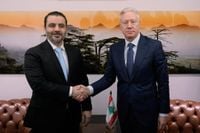On Friday, October 10, 2025, Beirut’s usually bustling diplomatic quarter was abuzz with a sense of historic change. Syrian Foreign Minister Asaad al-Shibani arrived in the Lebanese capital, marking the first high-profile visit by a Syrian official since insurgent groups toppled President Bashar Assad’s government in December 2024. The visit, reported by the Associated Press and SANA news agency, signaled a dramatic shift in the long and often fraught relationship between Lebanon and Syria—two neighbors whose destinies have been entwined, sometimes uncomfortably, for decades.
Al-Shibani’s agenda was packed. He met with Lebanese President Joseph Aoun, Prime Minister Nawaf Salam, and Foreign Minister Joe Rajji (sometimes cited as Youssef Raji in local reports). The message from both sides was clear: the time for a new era had come. As al-Shibani put it at a joint press conference, “There is a historic opportunity to turn the relationship between Syria and Lebanon from a tense security relationship in the past into a political and economic partnership that benefits both the Syrian and Lebanese peoples.” He emphasized Syria’s determination to “overcome all obstacles of the past with Lebanon and to strengthen ties based on mutual respect and shared interests.”
This wasn’t just rhetoric. The two governments announced the suspension of the Lebanese-Syrian Higher Council—a body created in 1991 under the Treaty of Brotherhood, Cooperation, and Coordination that had long symbolized Syria’s influence over Lebanon. The council’s role had dwindled since the withdrawal of Syrian troops in 2005, following the assassination of Lebanese Prime Minister Rafik Hariri and the opening of Syria’s embassy in Beirut in 2008. Now, as President Aoun confirmed, “In this context, we look forward to the appointment of a new Syrian ambassador to Lebanon to follow up on all matters through both embassies in Damascus and Beirut.”
The suspension of the council wasn’t just a bureaucratic shuffle. It represented a symbolic end to an era when Syria’s political and military sway over Lebanon was a fact of life—and a source of deep resentment for many Lebanese. For nearly three decades after Lebanon’s independence from France in 1943, Syrian troops and intelligence officials were a constant presence. Even after the so-called “Cedar Revolution” forced their withdrawal in 2005, the shadow of Damascus loomed large over Beirut’s politics.
But the regional landscape has changed dramatically in the past year. Assad’s ouster in December 2024, followed by Hezbollah’s heavy losses in its recent war with Israel, has upended old alliances and power structures. The new Syrian leadership, under President Ahmad al-Sharaa, appears eager to reset relations. “This visit comes under the direction of President Ahmed al Sharaa to affirm the depth of relations between the two countries and to embody the new Syria’s orientation based on mutual respect,” al-Shibani stated, according to SANA.
For Lebanon, the stakes are high. The country hosts an estimated 1.5 million Syrian refugees—giving it the highest per capita refugee population in the world. Since Assad’s fall, around 850,000 refugees have returned to Syria from neighboring countries as of September 2025, the UN refugee agency reports. Al-Shibani publicly thanked Lebanon for hosting Syrians “during the war and expect the issue of Syrian displacement to be resolved.” He added, “Plans are being discussed for a dignified and sustainable return that addresses the post-war situation in Syria.”
The refugee question is only one piece of a complex puzzle. The two governments are also working to address the fate of roughly 2,000 Syrian nationals detained in Lebanese prisons, many of whom are held without trial. About 800 of these detainees are suspected of involvement in attacks and shootings. At the same time, Lebanese officials are seeking information about Lebanese nationals who have gone missing in Syria—some for years, some for decades. In early September, a Syrian delegation including two former Cabinet ministers and the head of Syria’s National Commission for Missing Persons visited Beirut to discuss these sensitive issues. Both sides reaffirmed their commitment to forming joint committees to address detainees, missing persons, and other outstanding matters.
Border security is another perennial flashpoint. The Lebanon-Syria border, particularly in the northeastern Bekaa Valley, has long been a corridor for smuggling, infiltration, and occasional violence. In March 2025, after a deadly escalation in which armed men crossed into Syrian territory and killed three soldiers, the defense ministers of both nations agreed to a ceasefire and new measures to prevent further tensions. Soon after, Lebanon and Syria signed an agreement to demarcate the border and enhance security coordination, aiming to curb illicit activities—especially the movement of weapons and military supplies, often linked to Hezbollah’s operations. According to President Aoun, “the border situation has improved compared to the past.”
Economic cooperation is also on the table. In 2022, Lebanon, Syria, and Egypt agreed to ship 650 million cubic meters (23 billion cubic feet) of natural gas per year from Egypt through Syria to Lebanon’s Deir Ammar power plant. The project, if fully realized, could help ease Lebanon’s chronic electricity shortages—though implementation has been slow, hampered by regional instability and logistical hurdles.
Al-Shibani’s delegation to Beirut was a heavyweight one, including Syria’s justice minister Mazhar al-Louais al-Wais, the head of Syrian intelligence Hussein al-Salama, and assistant interior minister Maj. Gen. Abdel Qader Tahan. Their presence underscored the seriousness of Syria’s outreach. “My visit to Beirut is meant to reaffirm the depth of Syrian-Lebanese relations,” al-Shibani said, echoing his earlier remarks about moving beyond “previous obstacles” and building a partnership grounded in respect for sovereignty and non-interference.
The Lebanese side, for its part, appeared cautiously optimistic. Foreign Minister Joe Rajji declared, “A new page has been opened between Lebanon and Syria, and we hope it will be an auspicious beginning.” He further affirmed, “relations between the Lebanese and Syrian states are now direct.” The Foreign Ministry had been informed, through the Syrian Embassy in Beirut, that all communications would henceforth be conducted via official diplomatic channels—a significant departure from the opaque networks of the past.
Still, challenges remain. The wounds of Syria’s 29-year domination of Lebanon, and the scars of the recent civil war, are not easily healed. Sectarian violence continues to unsettle post-Assad Syria, with attacks on Alawite and Druze minorities reviving old fears. The fate of thousands of detainees and missing persons on both sides of the border weighs heavily on families and communities. And the shadow of Hezbollah—resented by the current Syrian leadership for its role in Syria’s war, and by many Lebanese for its entanglements with Iran and ongoing cross-border smuggling—continues to complicate the picture.
Yet, for the first time in years, there is a sense that both countries are willing to try something different. As al-Shibani put it, “Syria is entering a stage of recovery and reconstruction, one of the main foundations of which is building political relations on the principles of reciprocal cooperation, respect for the sovereignty of neighboring states, and non-interference in their internal affairs.” That might sound like diplomatic boilerplate, but in the context of Syrian-Lebanese history, it’s nothing short of revolutionary.
Whether this new chapter will bring the stability and prosperity both peoples crave remains to be seen. But for now, the doors between Damascus and Beirut are open wider than they have been in a generation—and that, in itself, is newsworthy.

